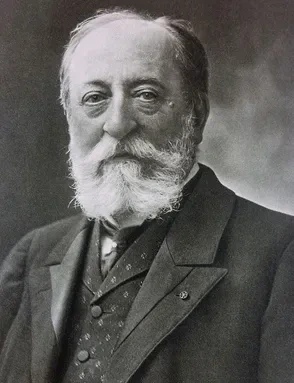
세자르 프랑크가 극히 신중한 태도로 한정된 분야의 몇 곡 안 되는 작품을 남긴 것과는 대조적으로, 프랑크와 나란히 근대 프랑스 음악의 아버지라고 불리는 생상스는 모든 장르에 걸쳐 수많은 작품을 썼다. 이것은 물론 두 사람의 천부적 재능의 차이에 의한 것이지만, 프랑크가 항상 투철한 비평 정신으로 하나의 작품이 마음에 들 때까지 추고를 거듭했던 것과는 달리, 생상스는 천재적인 재능을 바탕으로 자연스럽게 작곡해 나갔기 때문이다.
생상스 작품의 특징은 그 나름대로의 아름다운 선율을 가지고 경묘하고 화려한 프랑스풍의 스타일과 독일적인 구성을 결합시키려는 데 있다. 생상스의 바이올린 협주곡은 모두 3곡이 있는데 1번과 2번 협주곡은 오늘날 거의 연주되지 않으며, 생상스의 바이올린 협주곡이라면 바로 제3번을 생각할 정도로 이 곡이 널리 연주되고 있다. 이곳저곳에 아름다운 선율이 넘치며 고전 협주곡에 가까운 꽉 짜인 구성을 보이고 있는 그의 대표적인 작품 중 하나이다.
제1악장. 알레그로 논 트로포 나단조 2/4박자, 소나타 형식
이 악장은 대단히 변칙적인 소나타 형식으로 되어 있다. 즉 고전 협주곡의 정형에서는 병행 장조를 취하는 제2주제가 마장조로 제시되며, 그 재현에서는 정형대로 나장조로 연주된다. 그리고 제1주제는 전개부에 있어서 중요한 역할을 한 때문인지 재현할 때는 제2주제보다 늦게 나타난다.
제2악장. 안단티노 콰지 알레그레토 내림나장조 6/8박자, 소나타 형식
으뜸조에서 동떨어진 내림나장조에 의한 3부 형식풍의 소나타 형식으로 된 이 악장은 바르카롤을 연상케 하는 아름다운 선율과 출렁이는 듯한 리듬으로 된 매우 유명한 악장이다.
제3악장. 서주는 몰토 모데라토 에 마에스토소 나단조 4/4박자, 주부는 알레그로 논 트로포 나단조 2/2박자, 코다는 피우 알레그로 나장조 2/2박자
이 악장의 형식을 도식으로 설명하면 다음과 같다.
A1-A2-B-A2-C-A1-A2-B-A2-C-B
도식에서 보는 바와 같이 소나타적인 요소를 가진 론도 형식이라 할 수 있다. 조성 관계는 지극히 자유로우며 악장 전체가 유기적으로 연결되어 있다.
https://youtu.be/ZgQutR3Cz4Y?si=aqO9VYJRqEbweYod
In contrast to Cesar Franck, who was extremely cautious and left behind only a few works in a limited field, Saint-Saëns, who is called the father of modern French music alongside Franck, wrote numerous works across all genres. This is of course due to the difference in the two men's natural talents, but unlike Franck, who always continued to pursue a piece with a thorough critical spirit until he was satisfied with it, Saint-Saëns composed naturally based on his genius talent.
The characteristic of Saint-Saëns's work is that he tries to combine the light and splendid French style with German composition with his own beautiful melody. There are three violin concertos by Saint-Saëns, but the first and second are rarely performed today, and when it comes to Saint-Saëns' violin concertos, the third is the one that comes to mind. It is one of his representative works, with beautiful melodies overflowing here and there and a tight composition similar to a classical concerto.
1st movement. Allegro non troppo B minor 2/4, Sonata form
This movement is in a very irregular sonata form. That is, in the classical concerto form, the second theme, which takes a parallel major key, is presented in E major, and in the reprise, it is played in B major as usual. Also, the first theme appears later than the second theme when reprised, perhaps because it plays an important role in the development.
2nd movement. Andantino quasi allegretto Bb major 6/8, Sonata form
This movement, in the form of a three-part sonata in B flat major, which is far from the tonic key, is a very famous movement with a beautiful melody and rippling rhythm reminiscent of barcarol.
3rd movement. The introduction is Molto Moderato E Maestoso in B minor 4/4, the main part is Allegro Non Tropo in B minor 2/2, and the coda is Piu Allegro in B major 2/2
The form of this movement can be described schematically as follows:
A1-A2-B-A2-C-A1-A2-B-A2-C-B
As you can see from the diagram, it can be said to be a rondo form with sonata elements. The tonal relationship is extremely free, and the entire movement is organically connected.



